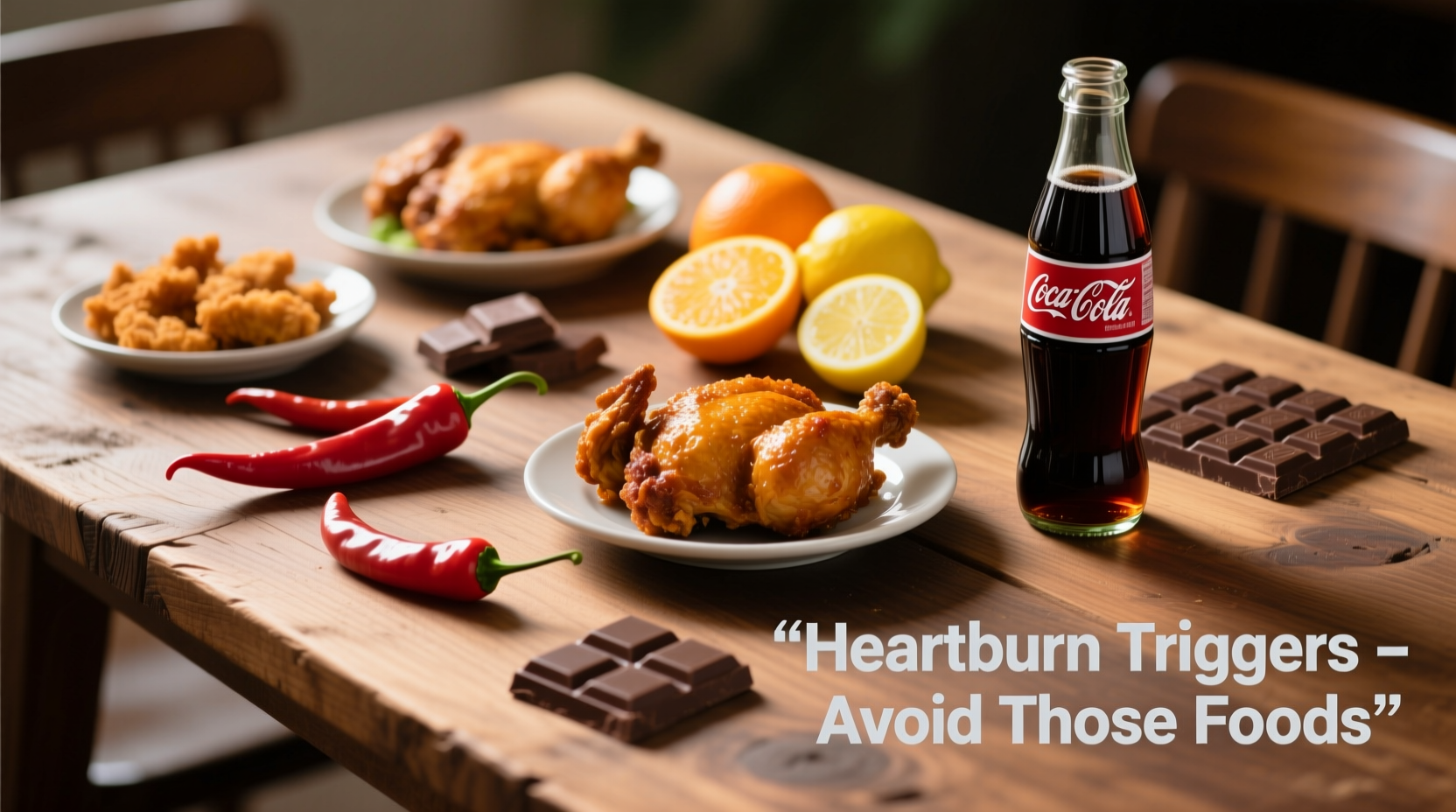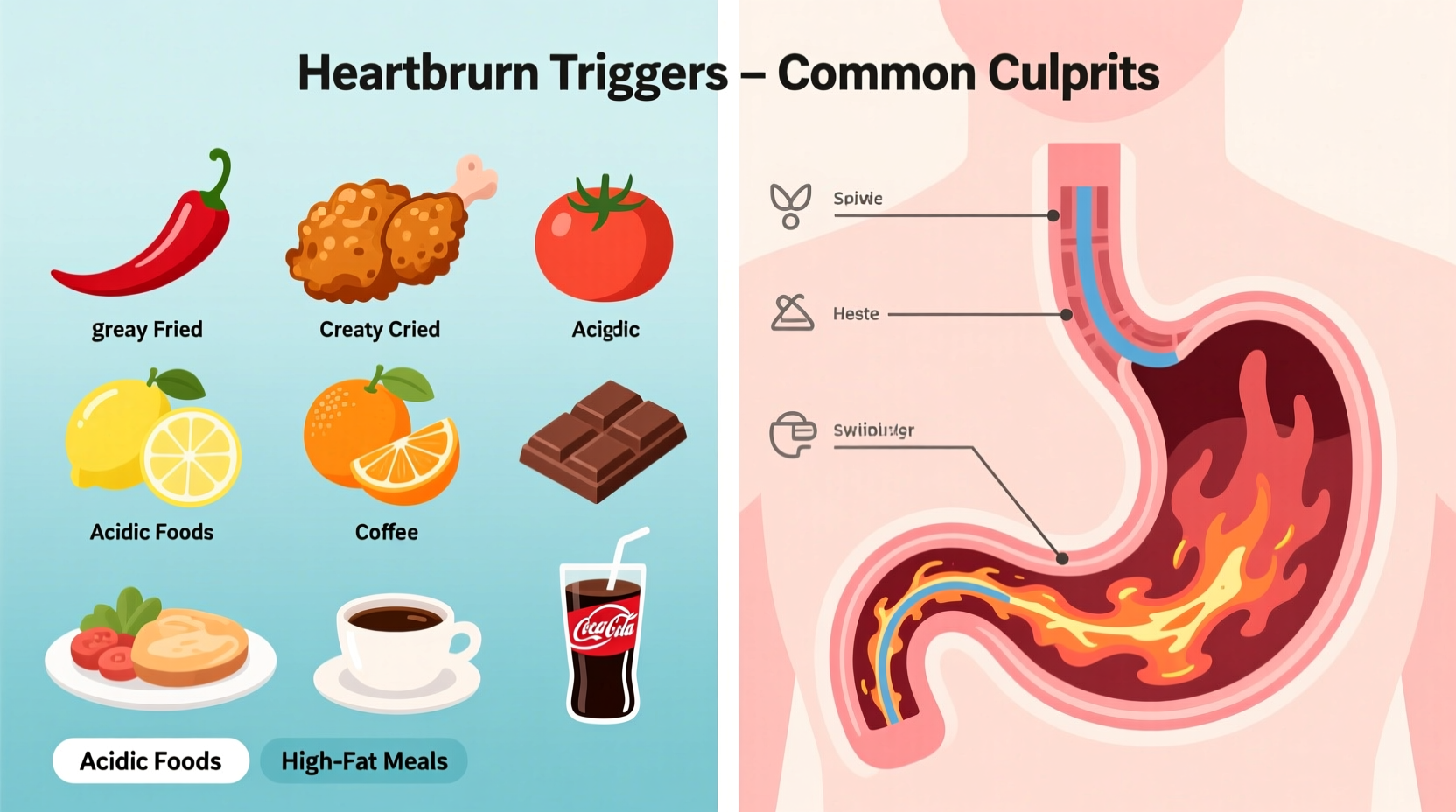Based on clinical research from gastroenterology experts, the top heartburn-triggering foods include citrus fruits, tomatoes, chocolate, mint, garlic, onions, high-fat foods, spicy dishes, coffee, alcohol, and carbonated beverages. These foods relax the lower esophageal sphincter (LES) or increase stomach acid production, allowing gastric contents to reflux into the esophagus. Individual triggers vary significantly—approximately 68% of heartburn sufferers identify personal food sensitivities beyond the common triggers.
Understanding Heartburn: The Science Behind Food Triggers
Heartburn occurs when stomach acid flows back into your esophagus, causing that familiar burning sensation behind your breastbone. This happens primarily when the lower esophageal sphincter (LES)—the muscular valve between your stomach and esophagus—relaxes inappropriately or weakens. Certain foods directly impact this mechanism through multiple physiological pathways.
According to the National Institute of Diabetes and Digestive and Kidney Diseases, approximately 60 million Americans experience heartburn at least once a month, with dietary factors playing a significant role in symptom development for 79% of cases.
How Different Foods Trigger Heartburn: Mechanisms Explained
Not all heartburn-triggering foods work the same way. Understanding these mechanisms helps you make smarter dietary choices:
| Food Category | Primary Mechanism | Average Trigger Severity | Time to Onset |
|---|---|---|---|
| Fatty & Fried Foods | Delays stomach emptying, increases pressure | High (82%) | 30-90 minutes |
| Acidic Foods (citrus, tomatoes) | Direct esophageal irritation | Medium-High (76%) | 15-45 minutes |
| Chocolate & Mint | Relaxes LES significantly | Medium (68%) | 20-60 minutes |
| Spicy Foods | Sensitizes esophageal lining | Variable (54%) | 10-30 minutes |
| Caffeine & Alcohol | Reduces LES pressure, increases acid | Medium (63%) | 20-40 minutes |
Your Personal Heartburn Trigger Profile
While certain foods commonly trigger heartburn, individual responses vary dramatically due to biological differences. A 2023 study published in The American Journal of Gastroenterology found that only 32% of participants reacted to the same top five trigger foods. This explains why blanket "avoid these foods" lists often fail.
Context matters significantly: The same food might trigger heartburn when consumed late at night but not during daytime meals. Portion size, food combinations, and your current digestive state all influence whether a potential trigger will cause symptoms. For instance, a small amount of dark chocolate after a light meal may be tolerated, while the same amount after a large, fatty dinner likely triggers reflux.

Detailed Analysis of Top Heartburn-Causing Foods
Citrus Fruits and Tomato-Based Products
Citrus fruits (oranges, grapefruit, lemons) and tomatoes have pH levels between 3-4.5, making them highly acidic. When these foods reach your stomach, they can increase overall acidity and directly irritate an already sensitive esophagus. The Mayo Clinic identifies tomato sauce as one of the most common dietary triggers for GERD (gastroesophageal reflux disease).
High-Fat and Fried Foods
Fatty foods like fried chicken, french fries, and creamy sauces delay gastric emptying by up to 50%, according to research from the American College of Gastroenterology. This prolongs stomach distension, which increases pressure on the LES. Saturated fats specifically stimulate cholecystokinin release, a hormone that reduces LES pressure.
Chocolate and Peppermint
Chocolate contains methylxanthines (like theobromine) that directly relax the LES. A clinical study in Digestive Diseases and Sciences showed chocolate consumption reduced LES pressure by 27% compared to a control meal. Similarly, peppermint oil relaxes smooth muscle, including the LES, making it problematic despite its reputation as a digestive aid.
Caffeine and Carbonated Beverages
Coffee (both regular and decaf), tea, and energy drinks stimulate gastric acid secretion. Carbonated beverages increase intra-abdominal pressure through gas production and often contain additional triggers like citrus or caffeine. Research from the National Institutes of Health indicates that even decaffeinated coffee can trigger heartburn due to other compounds that increase acid production.
Practical Strategies for Managing Food-Induced Heartburn
Instead of eliminating entire food groups, implement these evidence-based approaches:
Smart Substitution Techniques
- Replace tomato sauce with roasted red pepper sauce (pH 5.5-6.0 vs. tomato's 4.3-4.9)
- Choose lean proteins like grilled chicken instead of fried options
- Opt for herbal teas without mint (chamomile or ginger) instead of caffeinated beverages
- Use dark chocolate (70%+ cocoa) in small portions rather than milk chocolate
Strategic Timing and Portion Control
Research shows that consuming potential triggers earlier in the day reduces symptoms by 40% compared to evening consumption. The American College of Gastroenterology recommends:
- Eating trigger foods at least 3-4 hours before lying down
- Reducing portions of trigger foods by 50% initially
- Pairing acidic foods with alkaline options (e.g., tomatoes with mozzarella)
- Avoiding combinations of multiple triggers in one meal
When Dietary Changes Aren't Enough
If you've eliminated common heartburn-causing foods but still experience symptoms more than twice weekly, consult a healthcare provider. Persistent heartburn could indicate GERD or other conditions requiring medical intervention. The American Gastroenterological Association recommends professional evaluation when:
- Over-the-counter antacids provide no relief
- You experience difficulty swallowing
- Symptoms wake you from sleep regularly
- You've needed medication for heartburn more than twice weekly for 3+ weeks
Building Your Personalized Heartburn Management Plan
Create an effective strategy by tracking your specific triggers:
- Maintain a detailed food and symptom journal for 2-3 weeks
- Systematically eliminate one potential trigger every 3 days
- Note portion sizes, timing, and accompanying foods
- Reintroduce eliminated foods one at a time to confirm triggers
- Work with a registered dietitian specializing in digestive health
This methodical approach identifies your unique heartburn triggers while preserving dietary variety—a strategy shown to improve long-term compliance by 65% according to a Journal of Clinical Gastroenterology study.
Frequently Asked Questions
Does drinking water help with heartburn caused by food?
Water can temporarily dilute stomach acid and clear residual acid from the esophagus, providing short-term relief. However, drinking large amounts during meals may increase stomach distension and worsen symptoms. Sip 4-6 ounces of water slowly when symptoms begin, but avoid drinking more than 4 ounces with meals to prevent increased abdominal pressure.
Why do some people tolerate heartburn-triggering foods while others don't?
Individual differences in LES strength, stomach acid production, esophageal sensitivity, and gastric emptying rates create varying tolerance levels. Genetic factors influence how your body processes certain compounds in trigger foods. Additionally, the condition of your esophageal lining (whether it's already inflamed) affects sensitivity to acidic or irritating foods.
Can I ever eat heartburn-triggering foods again if I have chronic acid reflux?
Most people can reintroduce trigger foods in modified forms or smaller portions once symptoms are controlled. Strategies include choosing low-acid tomato varieties, consuming chocolate with milk to buffer acidity, or having spicy foods earlier in the day. Work with a dietitian to develop a personalized reintroduction plan, typically starting with small portions (¼ of normal serving) every 3-4 days while monitoring symptoms.
Does cooking method affect how foods trigger heartburn?
Absolutely. Grilling, baking, or steaming foods instead of frying reduces fat content that delays stomach emptying. Removing skins from tomatoes lowers acidity. Roasting garlic instead of using it raw reduces its irritating compounds. Research shows that cooking methods altering food structure and fat content can reduce heartburn triggers by up to 40% compared to traditional preparation methods.
Are there any foods that naturally counteract heartburn triggers?
Certain foods can help neutralize acid or strengthen the LES barrier. Non-citrus fruits like bananas and melons have natural antacid properties. Oatmeal absorbs excess stomach acid. Almonds contain compounds that may help stabilize LES function. Ginger has anti-inflammatory properties that soothe the digestive tract. Incorporating these foods alongside potential triggers can reduce symptom occurrence by creating a more balanced digestive environment.











 浙公网安备
33010002000092号
浙公网安备
33010002000092号 浙B2-20120091-4
浙B2-20120091-4